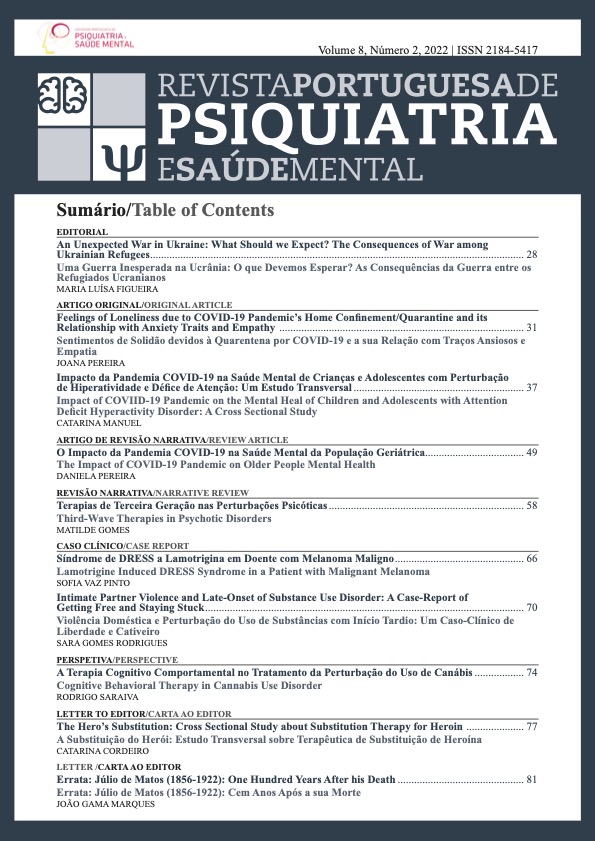Síndrome de DRESS a Lamotrigina em Doente com Melanoma Maligno
DOI:
https://doi.org/10.51338/rppsm.314Palavras-chave:
Lamotrigina/efeitos adversos, Melanoma/tratamento farmacológico, Polimedicação, Síndrome de Hipersensibilidade a Medicamentos/etiologiaResumo
DRESS syndrome (drug reaction with eosinophilia and systemic symptoms) is a rare and severe drug reaction with systemic involvement. We describe a clinical case of a patient diagnosed with malignant melanoma who showed in the emergency room with a generalized morbilliform rash, facial edema and asthenia. The patient had been medicated with pembrolizumab for the last 5 months and had begun lamotrigine for the treatment of a bipolar depression 14 days before the admission. Laboratory tests showed thrombocytopenia, eosinophilia, elevated CRP and abnormal liver function tests.
The clinical picture suggested a DRESS syndrome induced by lamotrigin. The drug was discontinued while systemic glucocorticoid treatment was initiated, with complete remission of DRESS symptoms in 30 days. Responsible drug withdrawal is the most important DRESS syndrome treatment measure regarding its major impact on morbidity and mortality outcomes. However, identifying the responsible agent in polymedicated patients is usually a difficult challenge.
Downloads
Referências
Bommersbach TJ, Lapid MI, Leung JG, Cunningham JL, Rummans TA, Kung S. Management of Psychotropic Drug–Induced DRESS Syndrome: A Systematic Review. Mayo Clin Proc. 2016;91(6):787–801.
Ganeva M, Gancheva T, Lazarova R, Troeva J, Baldaranov I, Vassilev I, et al. Carbamazepine-induced drug reaction with eosinophilia and systemic symptoms (DRESS) syndrome: Report of four cases and brief review. Int J Dermatol. 2008;47(8):853–860.
Criado PR, Avancini J, Santi CG, Medrado ATA, Rodrigues CE, Carvalho JF De. Drug Reaction with Eosinophilia and Systemic Symptoms (DRESS): A Complex Interactio of Drugs, Viruses and the Immune System. IMAJ. 2012;14:5–10.
Vaillant L. Drug hypersensitivity syndrome: Drug rash with eosinophilia and systemic symptoms (DRESS). J Dermatolog Treat. 1999;10(4):267–272.
Pinheiro AE, Ferreira R, Ferreira GC, Varandas L. Síndrome de hipersensibilidade aos antiepilépticos na criança. Acta Med Port. 2010;23(4):715–718.
Chu CY, Chen YC, Chiu HC. Drug reaction with eosinophilia and systemic symptoms: A retrospective study of 60 cases. Arch Dermatol. 2010;146(12):1373–1379.
Choudhary S, McLeod M, Torchia D, Romanelli P. Drug reaction with eosinophilia and systemic symptoms (DRESS) syndrome. Clin Dermatol. 2013;6(6):702–711.
Lobo I, Ferreira M, Velho G, Sanches M, Selores M. Erupção a fármaco com eosinofilia e sintomas sistémicos (Síndrome DRESS). Acta Med Port. 2008;21(4):367–372.
Tawhari I, Tawhari F, Aljuaid M. Lamotrigine-induced drug reaction with eosinophilia and systemic symptoms (DRESS) during primary Epstein-Barr virus (EBV) infection. BMJ Case Rep. 2018;2018:2017–2018.
Husain Z, Reddy BY, Schwartz RA. DRESS syndrome: Part II. Management and therapeutics. J Am Acad Dermatol. 2013;68(5):709.e1-709.e9.
Um SJ, Lee SK, Kim YH, Kim KH, Son CH, Roh MS, et al. Clinical features of drug-induced hypersensitivity syndrome in 38 patients. J Investig Allergol Clin Immunol. 2010;20(7):556–562.
Fleming P, Marik PE. The DRESS syndrome: The great clinical mimicker. Pharmacotherapy. 2011;31(3):3103. doi:10.1592/phco.31.3.332
Chen CB, Wu MY, Ng CY, Lu CW, Wu J, Kao PH, et al. Severe cutaneous adverse reactions induced by targeted anticancer therapies and immunotherapies. Cancer Manag Res. 2018;10:1259–1273.








